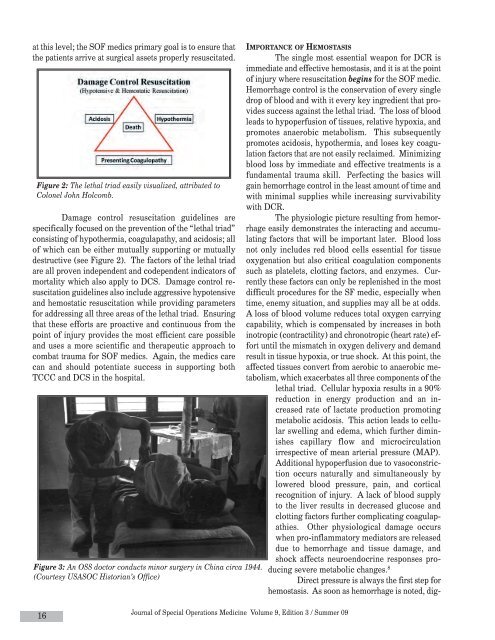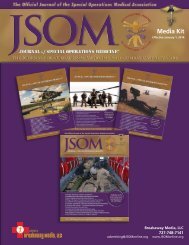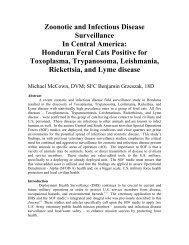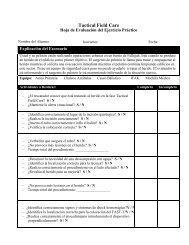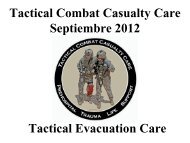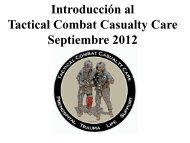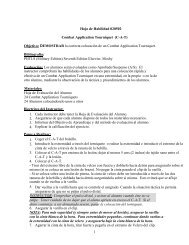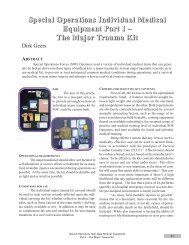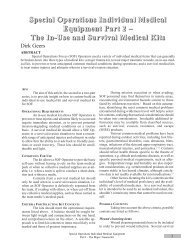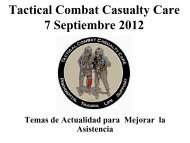Risk G. Hetzler M. Damage Control Resuscitation for the Special ...
Risk G. Hetzler M. Damage Control Resuscitation for the Special ...
Risk G. Hetzler M. Damage Control Resuscitation for the Special ...
Create successful ePaper yourself
Turn your PDF publications into a flip-book with our unique Google optimized e-Paper software.
at this level; <strong>the</strong> SOF medics primary goal is to ensure that<br />
<strong>the</strong> patients arrive at surgical assets properly resuscitated.<br />
Figure 2: The lethal triad easily visualized, attributed to<br />
Colonel John Holcomb.<br />
<strong>Damage</strong> control resuscitation guidelines are<br />
specifically focused on <strong>the</strong> prevention of <strong>the</strong> “lethal triad”<br />
consisting of hypo<strong>the</strong>rmia, coagulapathy, and acidosis; all<br />
of which can be ei<strong>the</strong>r mutually supporting or mutually<br />
destructive (see Figure 2). The factors of <strong>the</strong> lethal triad<br />
are all proven independent and codependent indicators of<br />
mortality which also apply to DCS. <strong>Damage</strong> control resuscitation<br />
guidelines also include aggressive hypotensive<br />
and hemostatic resuscitation while providing parameters<br />
<strong>for</strong> addressing all three areas of <strong>the</strong> lethal triad. Ensuring<br />
that <strong>the</strong>se ef<strong>for</strong>ts are proactive and continuous from <strong>the</strong><br />
point of injury provides <strong>the</strong> most efficient care possible<br />
and uses a more scientific and <strong>the</strong>rapeutic approach to<br />
combat trauma <strong>for</strong> SOF medics. Again, <strong>the</strong> medics care<br />
can and should potentiate success in supporting both<br />
TCCC and DCS in <strong>the</strong> hospital.<br />
Figure 3: An OSS doctor conducts minor surgery in China circa 1944.<br />
(Courtesy USASOC Historian’s Office)<br />
IMPORTANCE OF HEMOSTASIS<br />
The single most essential weapon <strong>for</strong> DCR is<br />
immediate and effective hemostasis, and it is at <strong>the</strong> point<br />
of injury where resuscitation begins <strong>for</strong> <strong>the</strong> SOF medic.<br />
Hemorrhage control is <strong>the</strong> conservation of every single<br />
drop of blood and with it every key ingredient that provides<br />
success against <strong>the</strong> lethal triad. The loss of blood<br />
leads to hypoperfusion of tissues, relative hypoxia, and<br />
promotes anaerobic metabolism. This subsequently<br />
promotes acidosis, hypo<strong>the</strong>rmia, and loses key coagulation<br />
factors that are not easily reclaimed. Minimizing<br />
blood loss by immediate and effective treatments is a<br />
fundamental trauma skill. Perfecting <strong>the</strong> basics will<br />
gain hemorrhage control in <strong>the</strong> least amount of time and<br />
with minimal supplies while increasing survivability<br />
with DCR.<br />
The physiologic picture resulting from hemorrhage<br />
easily demonstrates <strong>the</strong> interacting and accumulating<br />
factors that will be important later. Blood loss<br />
not only includes red blood cells essential <strong>for</strong> tissue<br />
oxygenation but also critical coagulation components<br />
such as platelets, clotting factors, and enzymes. Currently<br />
<strong>the</strong>se factors can only be replenished in <strong>the</strong> most<br />
difficult procedures <strong>for</strong> <strong>the</strong> SF medic, especially when<br />
time, enemy situation, and supplies may all be at odds.<br />
A loss of blood volume reduces total oxygen carrying<br />
capability, which is compensated by increases in both<br />
inotropic (contractility) and chronotropic (heart rate) ef<strong>for</strong>t<br />
until <strong>the</strong> mismatch in oxygen delivery and demand<br />
result in tissue hypoxia, or true shock. At this point, <strong>the</strong><br />
affected tissues convert from aerobic to anaerobic metabolism,<br />
which exacerbates all three components of <strong>the</strong><br />
lethal triad. Cellular hypoxia results in a 90%<br />
reduction in energy production and an increased<br />
rate of lactate production promoting<br />
metabolic acidosis. This action leads to cellular<br />
swelling and edema, which fur<strong>the</strong>r diminishes<br />
capillary flow and microcirculation<br />
irrespective of mean arterial pressure (MAP).<br />
Additional hypoperfusion due to vasoconstriction<br />
occurs naturally and simultaneously by<br />
lowered blood pressure, pain, and cortical<br />
recognition of injury. A lack of blood supply<br />
to <strong>the</strong> liver results in decreased glucose and<br />
clotting factors fur<strong>the</strong>r complicating coagulapathies.<br />
O<strong>the</strong>r physiological damage occurs<br />
when pro-inflammatory mediators are released<br />
due to hemorrhage and tissue damage, and<br />
shock affects neuroendocrine responses producing<br />
severe metabolic changes. 8<br />
Direct pressure is always <strong>the</strong> first step <strong>for</strong><br />
hemostasis. As soon as hemorrhage is noted, dig-<br />
16<br />
Journal of <strong>Special</strong> Operations Medicine Volume 9, Edition 3 / Summer 09


